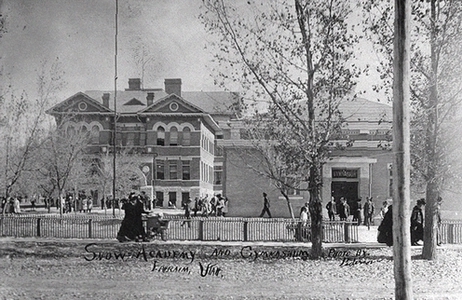SNOW COLLEGE

Snow College
Located in Ephraim, Snow College is a two-year community college operated within the Utah system of higher education.
Founded in 1888 by Mormon settlers in Sanpete County, Snow College was first called Sanpete Stake Academy and was begun at the urging of local LDS stake president Canute Peterson. Built entirely with local donations, the school had a rocky start as the locals struggled to finance their dream. The first classes were held on the top floor of the co-op store, a building still standing at the corner of 100 North Main Street in Ephraim. Newton E. Noyes served as school principal for twenty-nine years (1892-1921) and gave his name to the administration building, which was dedicated on 5 November 1909. Financial woes sent Noyes to LDS Church headquarters to plead for church assistance for the school, and Mormon Church President Lorenzo Snow authorized $2,000. In gratitude, the Sanpete patrons named the school Snow Academy after Lorenzo and his good friend and fellow Mormon leader Erastus Snow. The name of the school was changed to Snow Junior College, and in 1923 to its present name of Snow College.
The late 1920s and 1930s were a period of difficulty for education in Utah. The LDS Church wanted to divest itself of its schools around the state, and the state hesitated to take them over--both entities were concerned about the costs of running small schools. Snow finally became a state college in 1932-33. It continued to have strong support from the community and strong leadership under another long-term director, James A. Nuttall, who served from 1936 to 1953.
A celebration of the school's first fifty years in 1938 revealed the remarkable characteristics of this small school, including a strong and loyal alumni group, which boasts a long list of distinguished people; dedicated faculty who were willing to sacrifice salaries for the school's survival; and a common feeling that those affiliated with the school have called the "Spirit of Snow."
Attempts by Governor J. Bracken Lee to return Snow and other schools to the LDS Church were opposed by a grass-roots movement of junior college patrons. They were able to put the proposed change before the voters, and it was rejected by a two to one majority in November 1954.
In 1951 Snow became a branch institution of the Utah State Agricultural College (now Utah State University) in Logan. It remained under USU until 1969 when it separated and became a member of the state system. The faculty's choice of director, Floyd S. Holm, was appointed in 1958 and served until 1974. Under Holm, the school made a significant transition from fighting for its existence to being able to stress academic excellence.
The campus grew as more buildings were built, including an impressive Activity Center. Even greater physical growth occurred with the acquisition of existing buildings and land west of Ephraim. Former Snow Collge president Steven D. Bennion (1982-89) was responsible for the state funding of a Career Center on the West Campus and the beginning of a foundation to acquire funds for the college and its students.
Besides having an outstanding staff, the school has been recognized for its theater productions, music contributions, women's volleyball program, football program (including the 1985 Division II national championship team), a nationally ranked forensics program (which also took top honors in 1985), and an award-winning 1987 yearbook. The school is internationally recognized for its ESL (English as a Second Language) program, which draws students from all over the world. Snow was the first two-year college in Utah to begin an honors program that was recognized by the state universities, allowing students to enter those schools' honors programs as juniors at the completion of their two years at Snow. Snow College takes its greatest pride from being recognized as a premier transfer institution. The 1989-90 year brought the largest student body (1,734) ever to the campus, as well as a new president, Gerald J. Day.
Disclaimer: Information on this site was converted from a hard cover book published by University of Utah Press in 1994. Any errors should be directed towards the University of Utah Press.